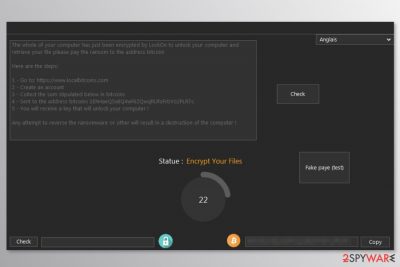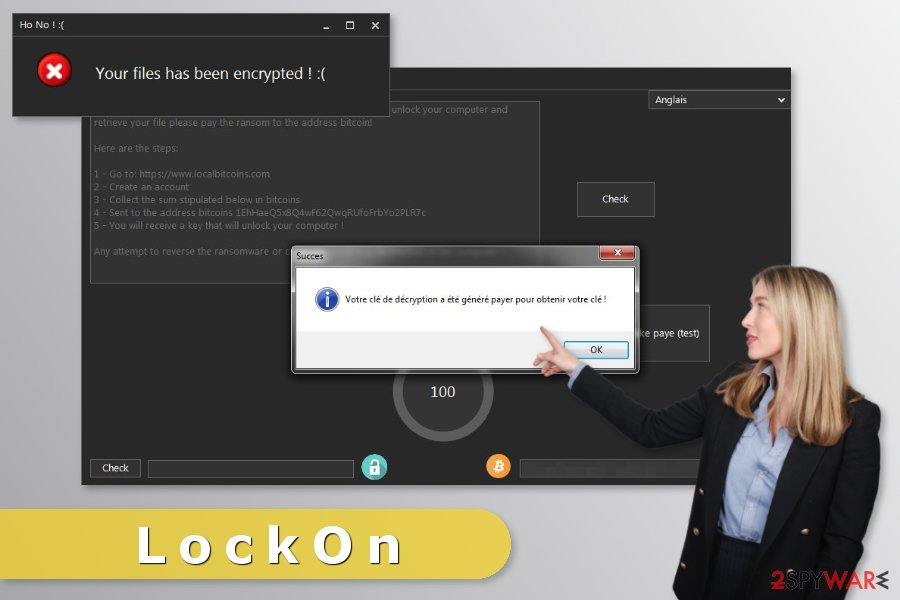LockOn ransomware / virus (Free Instructions) - Recovery Instructions Included
LockOn virus Removal Guide
What is LockOn ransomware virus?
LockOn is another HiddenTear inspired virus

LockOn is a ransomware virus that was discovered at the beginning of October 2017. The virus is based on HiddenTear project[1] and uses AES encryption algorithm to lock files on the targeted computer. Following data encryption, crypto-virus shows a program window with a ransom-demanding message.
The virus is written on Lockon Ransomware.exe file. However, it spreads as a [HOT][+18] CHECKER PORN.exe. It seems that people who are interested in adult-themed content might install malicious payload from torrents, file-sharing sites or P2P networks. However, other distribution methods might be used as well.
LockOn ransomware only aims at files that are located in C:\Users\Exploits\Desktop\test directory. When targeted documents, audio, video, image and other data are taken to the hostage, cyber-criminals inform users about the encryption. Judging from the ransom note, the virus aims at English and French[2] computer users.
The ransom-demanding window shows the status of encrypted files and provides instructions how to buy and transfer Bitcoins. Victims are warned that other attempts to remove LockOn or try to restore data will end up with a complete destruction of the device. However, these talks are just a psychologic terror used for threatening people to follow the instructions.
However, doing that is not recommended. Nevertheless, criminals promise to provide decryption key which is supposed to unlock an infected computer; it may not be true. The LockOn virus is based on HiddenTear which is a decryptable ransomware.[3] Therefore, its decryptor might help to restore files as well.
Therefore, after the attack, you should concentrate on LockOn removal and do not believe in threatening hackers’ warnings. For ransomware elimination, you will need to obtain a professional malware removal program, such as FortectIntego. Though, ransomware might modify Registry and affect various system processes in order to boot with system startup and prevent from elimination.
However, you can reboot the device to Safe Mode with Networking as shown in the instructions below and perform automatic elimination without any worries. Please, do not try to locate and remove malicious components from the system manually. It might be dangerous!

Important security measures to avoid ransomware attack
Developers of the ransomware often use several strategies to reach as much computer users as possible. LockOn authors are most likely aim at people who download adult-themed content from various online sources. However, downloading illegal movies, videos or similar entries is one of the biggest risks to install malware instead. Thus, rule number one – stay away from the illegal content.
Additionally, file-encrypting viruses might be distributed using one of these methods:
- malicious spam emails with infected links, buttons or attachments;
- exploit kits;
- malicious ads that might be placed on legit and potentially dangerous sites;
- weak RDP connections.
To avoid ransomware, you have to not only install powerful antivirus but watch your steps and clicks online. Therefore, never open unknown email attachments or click suspicious links. Also, keep all your software updated.
Terminate LockOn ransomware virus from the computer safely
The only safe way to remove LockOn from the device is to rely on reputable malware removal software. To ensure smooth elimination, you should reboot the computer to Safe Mode with Networking and then install FortectIntego, Malwarebytes or your preferred anti-malware tool. But before running a full system scan, you should update the security software.
After LockOn removal, you can restore your files from backups. Additionally, you can try HiddenTear decryptor or other alternative methods that are presented at the end of the article.
Getting rid of LockOn virus. Follow these steps
Manual removal using Safe Mode
Follow these steps to reboot the computer to Safe Mode with Networking:
Important! →
Manual removal guide might be too complicated for regular computer users. It requires advanced IT knowledge to be performed correctly (if vital system files are removed or damaged, it might result in full Windows compromise), and it also might take hours to complete. Therefore, we highly advise using the automatic method provided above instead.
Step 1. Access Safe Mode with Networking
Manual malware removal should be best performed in the Safe Mode environment.
Windows 7 / Vista / XP
- Click Start > Shutdown > Restart > OK.
- When your computer becomes active, start pressing F8 button (if that does not work, try F2, F12, Del, etc. – it all depends on your motherboard model) multiple times until you see the Advanced Boot Options window.
- Select Safe Mode with Networking from the list.

Windows 10 / Windows 8
- Right-click on Start button and select Settings.

- Scroll down to pick Update & Security.

- On the left side of the window, pick Recovery.
- Now scroll down to find Advanced Startup section.
- Click Restart now.

- Select Troubleshoot.

- Go to Advanced options.

- Select Startup Settings.

- Press Restart.
- Now press 5 or click 5) Enable Safe Mode with Networking.

Step 2. Shut down suspicious processes
Windows Task Manager is a useful tool that shows all the processes running in the background. If malware is running a process, you need to shut it down:
- Press Ctrl + Shift + Esc on your keyboard to open Windows Task Manager.
- Click on More details.

- Scroll down to Background processes section, and look for anything suspicious.
- Right-click and select Open file location.

- Go back to the process, right-click and pick End Task.

- Delete the contents of the malicious folder.
Step 3. Check program Startup
- Press Ctrl + Shift + Esc on your keyboard to open Windows Task Manager.
- Go to Startup tab.
- Right-click on the suspicious program and pick Disable.

Step 4. Delete virus files
Malware-related files can be found in various places within your computer. Here are instructions that could help you find them:
- Type in Disk Cleanup in Windows search and press Enter.

- Select the drive you want to clean (C: is your main drive by default and is likely to be the one that has malicious files in).
- Scroll through the Files to delete list and select the following:
Temporary Internet Files
Downloads
Recycle Bin
Temporary files - Pick Clean up system files.

- You can also look for other malicious files hidden in the following folders (type these entries in Windows Search and press Enter):
%AppData%
%LocalAppData%
%ProgramData%
%WinDir%
After you are finished, reboot the PC in normal mode.
Remove LockOn using System Restore
System Restore might also be used to disable the virus.
-
Step 1: Reboot your computer to Safe Mode with Command Prompt
Windows 7 / Vista / XP- Click Start → Shutdown → Restart → OK.
- When your computer becomes active, start pressing F8 multiple times until you see the Advanced Boot Options window.
-
Select Command Prompt from the list

Windows 10 / Windows 8- Press the Power button at the Windows login screen. Now press and hold Shift, which is on your keyboard, and click Restart..
- Now select Troubleshoot → Advanced options → Startup Settings and finally press Restart.
-
Once your computer becomes active, select Enable Safe Mode with Command Prompt in Startup Settings window.

-
Step 2: Restore your system files and settings
-
Once the Command Prompt window shows up, enter cd restore and click Enter.

-
Now type rstrui.exe and press Enter again..

-
When a new window shows up, click Next and select your restore point that is prior the infiltration of LockOn. After doing that, click Next.


-
Now click Yes to start system restore.

-
Once the Command Prompt window shows up, enter cd restore and click Enter.
Bonus: Recover your data
Guide which is presented above is supposed to help you remove LockOn from your computer. To recover your encrypted files, we recommend using a detailed guide prepared by 2-spyware.com security experts.If your files are encrypted by LockOn, you can use several methods to restore them:
Data Recovery Pro – alternative tool to restore files
This program is originally created to restore files after system wreckage or deletion. However, it might be useful after ransomware attack too.
- Download Data Recovery Pro;
- Follow the steps of Data Recovery Setup and install the program on your computer;
- Launch it and scan your computer for files encrypted by LockOn ransomware;
- Restore them.
Windows Previous Versions feature
This Windows feature allows accessing previously saved versions of the files. However, you can follow these steps only if System Restore has been enabled before ransomware attack.
- Find an encrypted file you need to restore and right-click on it;
- Select “Properties” and go to “Previous versions” tab;
- Here, check each of available copies of the file in “Folder versions”. You should select the version you want to recover and click “Restore”.
ShadowExplorer might recover some of the files encrypted by LockOn
If malware did not delete Shadow Volume Copies of the encrypted files, this tool is a life-saver!
- Download Shadow Explorer (http://shadowexplorer.com/);
- Follow a Shadow Explorer Setup Wizard and install this application on your computer;
- Launch the program and go through the drop down menu on the top left corner to select the disk of your encrypted data. Check what folders are there;
- Right-click on the folder you want to restore and select “Export”. You can also select where you want it to be stored.
HiddenTear decryptor
LockOn malware is based on the HiddenTear project. Thus, its decryptors might help to restore files. Click these links to download and try the software for free:
Finally, you should always think about the protection of crypto-ransomwares. In order to protect your computer from LockOn and other ransomwares, use a reputable anti-spyware, such as FortectIntego, SpyHunter 5Combo Cleaner or Malwarebytes
How to prevent from getting ransomware
Do not let government spy on you
The government has many issues in regards to tracking users' data and spying on citizens, so you should take this into consideration and learn more about shady information gathering practices. Avoid any unwanted government tracking or spying by going totally anonymous on the internet.
You can choose a different location when you go online and access any material you want without particular content restrictions. You can easily enjoy internet connection without any risks of being hacked by using Private Internet Access VPN.
Control the information that can be accessed by government any other unwanted party and surf online without being spied on. Even if you are not involved in illegal activities or trust your selection of services, platforms, be suspicious for your own security and take precautionary measures by using the VPN service.
Backup files for the later use, in case of the malware attack
Computer users can suffer from data losses due to cyber infections or their own faulty doings. Ransomware can encrypt and hold files hostage, while unforeseen power cuts might cause a loss of important documents. If you have proper up-to-date backups, you can easily recover after such an incident and get back to work. It is also equally important to update backups on a regular basis so that the newest information remains intact – you can set this process to be performed automatically.
When you have the previous version of every important document or project you can avoid frustration and breakdowns. It comes in handy when malware strikes out of nowhere. Use Data Recovery Pro for the data restoration process.
- ^ Hidden Tear Project: Forbidden Fruit Is the Sweetest. Tripwire. Advanced threat detection and file integrity monitoring.
- ^ Les Virus. Les Virus. French cyber security and malware news.
- ^ Gabriela Vatu. Avast Releases Three New Decryption Tools to Fight Ransomware. Softpedia news. News articles, blog posts, reviews and editorials.





















